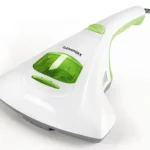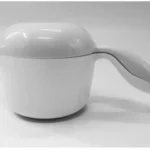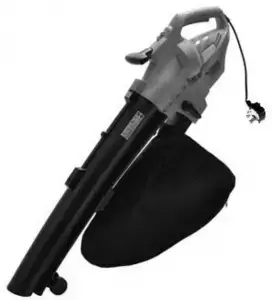
Coopers Leaf Blower Vac

OPERATING CONTROLS
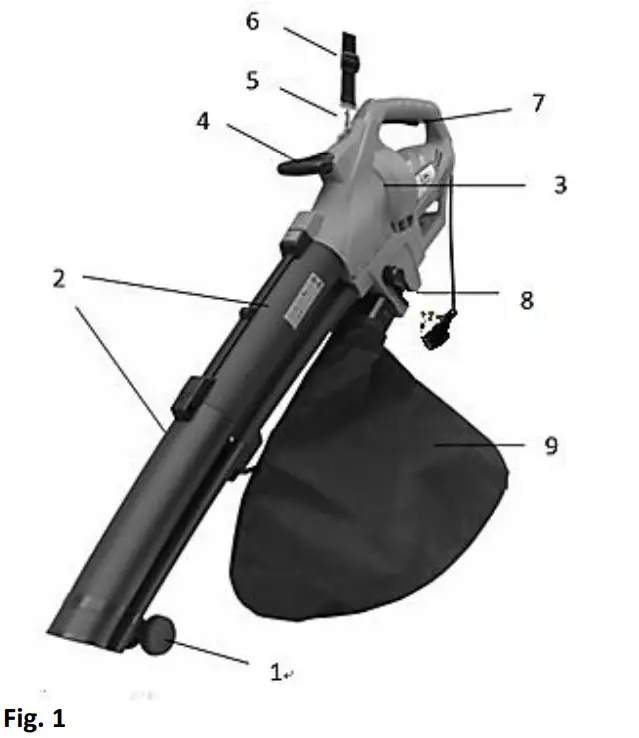
- Wheel
- Blower/Suction tube
- Blower/Vacuum body
- Auxiliary handle
- Hole for belt hook
- Shoulder belt
- Switch trigger
- Vacuum/Blower selector lever
- Collection Bag
CONTENTS
- Leaf blower body (1 set)
- tube (2pcs)
- collection bag (1pc)
- shoulder belt (1pc)
- short special screw ST4x14 (1pc)
- longer screw ST4 x 50 ( 2pcs)
TECHNICAL DATA
| Model No | DT2206A |
| Voltage / Frequency | 220V-240V/50Hz |
| Input Power | 2800W |
| No Load Speed | 15,000/min |
| Max. air speed: 270KM/H | 270km/h |
| Max. air volume | 13.2m³/min |
| Collection bag | 45L |
| Mulching rate | 10 : 1 |
| Item Net Weight (with extension lead) | 3.73kg |
| – Sound pressure level (in accordance with EN 50636-2-100) | Blower – 83.54dB(A) Vacuum – 82.40dB(A) K=3dB |
| – Sound power level (in accordance with EN 50636-2-100) | Blower- 94.73dB Vacuum- 101.08dB(A) K=3dB |
| – Guaranteed sound power level (in accordance with 2000/14/EC, amended by 2005/88/EC) | 105dB(A) |
| – Vibration (in accordance with EN 50636-2-100) | 7.655m/s2 K=1.5m/s2 |
Symbol Explanation
 There is a risk that stones and other objects could be thrown out by the appliance. Keep other people and domestic animals at a safe distance. There is a risk that stones and other objects could be thrown out by the appliance. Keep other people and domestic animals at a safe distance. |
|
 Keep hands out of rotation fan Keep hands out of rotation fan |
 Always disconnect the machine from the power mains before cleaning inspecting, repairing or when it is damaged or tangled. Always disconnect the machine from the power mains before cleaning inspecting, repairing or when it is damaged or tangled. |
 Do not use this product in the rain or leave outdoors while it is raining Do not use this product in the rain or leave outdoors while it is raining |
 Remove plug from the mains immediately if cable is damaged or cut. Remove plug from the mains immediately if cable is damaged or cut. |
 Wear eye protection Wear eye protection |
 Wear dust mask Wear dust mask |
 Class II tools symbol Class II tools symbol |
 In accordance with essential applicable safety standards of European directives In accordance with essential applicable safety standards of European directives |
 Waste electrical products should not be disposed of with household waste. Please recycle where facilities exist. Check with your local Authority or retailer for recycling advice Waste electrical products should not be disposed of with household waste. Please recycle where facilities exist. Check with your local Authority or retailer for recycling advice |
|
 Wear hearing protection while operating the power tool
Wear hearing protection while operating the power tool
The declared vibration total value has been measured in accordance with a standard test method and may be used for comparing one tool with another.
The declared vibration total value may also be used in a preliminary assessment of exposure.
WARNING
The vibration emission during actual use of the power tool can differ from the declared total value depending on the ways in which the tool is used.
There is the need to identify safety measures to protect the operator that are based on an estimation of exposure in the actual conditions of use (taking account of all parts of the operating cycle such as the times when the tool is switched off and when it is running idle in addition to the trigger time).
GENERAL SAFETY INSTRUCTIONS
Before attempting to operate this machine, it is important that you read, understand and follow these instructions very carefully. They are designed for the safety of yourself and others and to ensure a long and trouble free service life from your machine.
This appliance is not intended for use by persons (including children) with reduced physical, sensory or mental capabilities, or lack of experience and knowledge, unless they have been given supervision or instruction concerning use of the appliance by a person responsible for their safety.
Children should be supervised to ensure that they do not play with the appliance.
Training
- Read the instructions carefully. Be familiar with the controls and the proper use of the appliance.
- Never allow children to use the appliance.
- Never allow people unfamiliar with these instructions to use the appliance. Local regulations may restrict the age of the operator.
- Never operate the appliance while people, especially children, or pets are nearby.
- The operator or user is responsible for accidents or hazards occurring to other people or their property.
Preparation
- While operating the appliance, always wear substantial footwear and long trousers.
- Do not wear loose clothing or jewellery that can be drawn into the air inlet. Keep long hair away from the air inlets.
- Wear protective goggles while operating.
- To prevent dust irritation the wearing of a face mask is recommended.
- Before using, check the supply and extension cord for signs of damage and aging. Do not use the appliance if the cord is damaged or worn.
- Never operate the appliance with defective guards or shields, or without safety devices, for example debris collector in place.
- Only use a weather proof extension cable fitted with a coupler according to IEC 60320-2-3.
Operation
- Always direct the cable to the rear away from the appliance.
- If a cord becomes damaged during use, disconnect the supply cord from the mains immediately. DO NOT TOUCH THE CORD BEFORE DISCONNECTING THE SUPPLY.
- If the supply cord is damaged, it must be replaced by a qualified electrician in order to avoid a hazard.
- When using an extension cord, it shall not be less than H05VV-F 2×1.0mm²)(10 Amps).
- Do not carry the appliance by the cable.
- Disconnect the appliance from the mains supply
– whenever you leave the machine;
– before clearing a blockage;
– before checking, cleaning or working on the appliance;
– if the appliance starts to vibrate abnormally. - Operate the appliance only in daylight or in good artificial light.
- Do not overreach and keep your balance at all times.
- Always be sure of your footing on slopes.
- Walk, never run.
- Keep all cooling air inlets clear of debris.
- Never blow debris in the direction of bystanders.
- Recommendation to operate the machine only at reasonable hours- not early in the morning or late at night when people might be disturbed.
- Recommendation to use rakes and brooms to loosen debris before blowing/vacuuming.
- Recommendation to slightly dampen surface in dusty conditions.
Maintenance and storage
- Keep all nuts, bolts and screws tight to be sure the appliance is in safe working condition.
- Check the debris collector frequently for wear or deterioration.
- Replace worn or damaged parts.
- Use only genuine replacement parts and accessories.
- Store the appliance only in a dry place.
- Check all parts are secure and clean before each use.
SAFE OPERATION
Know Your Power Tool
It is important that you have read and understood your instruction manual and any label attached to the power tool. Learn its applications as well as its limitations and the potential hazards associated with this power tool.
Work Environment
Do not expose your power tools to rain, or use in damp or wet locations. Keep the work area well lit. Do not use power tools in areas where there is a risk of explosion or fire from combustible materials, flammable liquids, paint, varnish, petrol etc. Flammable gases and dust of an explosive nature, as a precaution it’s recommended that you consult an expert on a suitable fire extinguisher and its use.
Guard Against Electric Shock
Avoid body contact with earthed or grounded surface (e.g. pipes, radiators, ranges, and refrigerators).
Beware Children and Pets
Children and pets should be kept out of the work area. Children should not be allowed to touch or operate machinery or touch extension cords. All power tools should be kept out of the reach of children, preferably stored or locked in a secure cabinet or room when not in use.
Use the right tool
Select the right tool for the job. Do not use tools for a job for which it was not designed. Do not force a small tool to do the job of a heavy-duty tool. Do not use tools for purposes not intended.
PERSONAL SAFETY
Clothing
Do not wear loose clothing or jewellery that could get caught in moving machinery.
Hair
Long hair should be tied back and contained in a protective covering.
Eye Protection
The use of safety goggles is required (normal glasses are not sufficient for eye protection).
Ear Protection
Ear protection is advised during periods of extended operation.
Footwear
Where there is a risk of a heavy object damaging feet or there is a risk of slipping on wet or slippery floors suitable non-slip safety footwear should be worn.
Head Protection
Where there is a risk of falling objects or hitting your head on protruding or low level obstructions a hard hat should be worn.
Do Not Abuse the Power Cord
Never yank or pull on the power cord to disconnect it from the mains supply socket. Never carry your power tool by its power cord. Keep the power cord away from heat, oil, solvents and sharp edges. If the power cord becomes damaged have it replaced by an authorized service facility.
Do Not Over-reach
Do not over-reach, keep proper footing and maintain your balance at all times.
Maintain Tools with Care
Follow the instructions for lubricating and changing accessories.
Check the tool power cord periodically and if damaged have it replaced by an authorized service facility.
Inspect extension cords periodically and if damaged replace it.
Keep handles dry, clean and free from oil and grease.
Ensure that ventilation slots are kept clean and free from dust at all times.
Blocked ventilation slots can cause overheating and damage to the motor.
Disconnect Power Tools
Ensure that power tools are disconnected from the mains supply when not in use, before servicing, lubricating or making adjustments and when changing accessories such as blades, bits and cutters.
Avoid Unintentional Starting
Ensure that the switch is in the OFF position before plugging the power tool into the mains supply.
Extension Cords and Reels
The appliance should be supplied via a residual current device (RCD) with a tripping current of not more than 30 mA.
When the power tool is to be used outdoors, use only extension cords intended for outdoor use and are so marked.
Always unwind any extension cords fully.
For extension cords up to 15 meters use a wire cross section of 1.5mm2.
For extension cords over 15 meters but less than 40 meters use a wire cross section of 2.5mm2.
Always replace a damaged extension cord before using it.
Protect your extension cord from sharp objects, excessive heat and damp or wet locations.
Stay Alert
Watch what you are doing, use common sense, and do not operate the power tool when you are tired, if taking medication that causes drowsiness, when having consumed alcohol or taken drugs.
Check Damaged Parts
Before using the power tools it should be carefully checked to determine that it will operate properly and perform its intended function.
Check for the correct alignment of moving parts ensuring they do not bind. Check for broken or missing parts and have them replaced or repaired at an authorized service centre. Check any other condition that may affect the operation of the power tool.
A guard or any other part of the power tool that is damaged should be properly repaired or replaced by an authorized service centre unless otherwise indicated in this instruction manual.
Any switch that does not operate correctly must be replaced by an authorized service centre.
Do not use the power tool if the ON/OFF switch does not turn the power tool ON and OFF.
Warning
Do not attempt to modify the power tool in any way. The use of any attachment or accessory other than those recommended in this instruction manual could result in damage to the power tool and injury to the operator.
Have your power tool repaired by an authorised service facility.
This electric power tool complies with national and international standards and safety requirements. Repairs should only be carried out by qualified persons and using original spare parts. Failure to do so may result in considerable danger to the user.
Fire Precautions
When using certain power tools inside your house or workshop general fire precautions should be observed.
As a precaution it is recommended that an expert is consulted on obtaining and using a suitable fire extinguisher
SPECIFIC SAFETY INSTRUCTIONS- LEAF BLOWER VAC
 WARNING!
WARNING!
Never allow children or people who have not read and understood these instructions to use the Leaf Blower Vac. Do not use the Leaf Blower Vac for any purpose other than those described in these instructions.
Study the warning stickers on the machine, and replace any damaged or illegible warning stickers.
Read these instructions carefully. Find out what the controls do and learn how to use the machine correctly and safely.
The user is responsible for any accidents that happen to other people or their property.
Preparation
- Always wear suitable clothing, gloves and stout shoes. The use of approved safety goggles is recommended.
- Before using your Leaf Blower Vac always visually inspect it to see that any parts are not worn or damaged. Replace worn or damaged parts. Always inspect the insulation on the power cord and any extension cable to be used, for cuts, and abrasions and the condition of connectors. Any cable that is cut or worn and any damaged connectors should be replaced before using the Leaf Blower Vac.
- Always check that there is no material left in the Leaf Blower Vac before starting. This could be dangerous.
- Always check the operation of the Residual Current Device (R.C.D.) before every use.
- Only use replacement parts, recommended for this product.
- Take care when carrying out any repair or adjustment.
- A Leaf Blower Vac that has been modified or is incomplete is dangerous and no attempt should be made to operate it.
USING YOUR LEAF BLOWER VAC
- Always check the area to be worked, for wire and other debris etc, that could cause damage to the Leaf Blower Vac and injury to the operator.
- Never feed hard objects such as stones, bottles, cans or pieces of metal into the Leaf Blower Vac.
They can cause damage to the machine and possible injury to the operator and bystanders. - Never use the machine if there are people, especially children, or animals nearby.
- Never let any person who is not familiar with these instructions operate this machine.
- Avoid operating the Leaf Blower Vac in wet conditions, wherever possible.
- Know how to stop the Leaf Blower Vac quickly in an emergency.
- Never operate the Leaf Blower Vac if any of the guards are damaged, incorrectly fitted or missing.
- Make sure that you have adopted a safe and secure operating position before using the Leaf Blower Vac.
- Make sure that all nuts and bolts are secure before starting the Leaf Blower Vac.
- Only use the Leaf Blower Vac in dry surroundings never outdoors in the rain.
- Do not use the Leaf Blower Vac if it has a faulty safety device or if a guard is missing.
- Special care should be taken when cleaning. This should only be done with the Leaf Blower Vac switched off and disconnected from the mains supply to prevent injury.
- Ensure that the cable and any extension cable used are checked for damage and are coiled correctly without kinks.
- Before leaving the Leaf Blower Vac unattended;
- Before clearing any blockage;
- Before checking, cleaning or carrying out any work.
- If a foreign body, or other debris, is accidentally fed into the Leaf Blower Vac, stop it immediately and do not use the Leaf Blower Vac until it has been checked and you are sure that the entire Leaf
Blower Vac is in a safe operating condition. - If the Leaf Blower Vac makes any unusual noise or starts to vibrate abnormally, STOP it immediately, remove the plug from the mains supply and investigate the cause. Excessive vibration can cause damage to the Leaf Blower Vac and injury to the operator.
 Residual risks
Residual risks
Even when the tool is used as prescribed it is not possible to eliminate all residual risk factors. The following hazards may arise in connection with the tool’s construction and design:
- Damage to lungs if an effective dust mask is not worn.
- Damage to hearing if effective hearing protection is not worn.
- Health defects resulting from vibration emission if the power tool is being used over longer period of time or not adequately managed and properly maintained.
WARNING! This machine produces an electromagnetic field during operation. This field may under some circumstances interfere with active or passive medical implants. To reduce the risk of serious or fatal injury, we recommend persons with medical implants to consult their physician and the medical implant manufacturer before operating this machine.
INTENDED USE
This appliance should only be used for blowing or collecting leaves and debris to clean your garden around your home, not intended for commercial use. Other use of the appliance, not included in this manual, could damage the appliance or seriously injure the operator.
ASSEMBLY AND ADJUSTMENTS
Warning!
The Leaf Blower Vac must not be used or switched on until it has been fully assembled.
Fig. 2

Assembly (Fig.3 and Fig.4 )
Remove the two suction/blower tubes, one Vacuum-blower body (3), three screws that are in the manual bag from package. (Fig. 2)
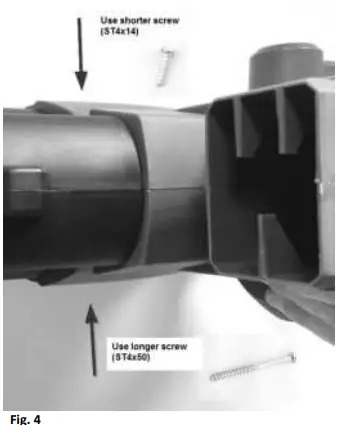
To assemble the two parts of the blower/suction tube, push tube 2-2 into tube 2-1. Then fasten with screw until they are well connected. Please see Fig. 3, and then put the assembled tube into the Blower/Vacuum body and secure with two provided screw, as illustrated in Fig. 4 with one short and one longer screw.
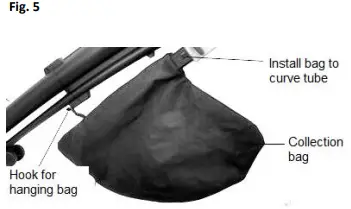
WARNING: IF ANY PART IS MISSING OR DAMAGED, DO NOT PLUG IN THE MACHINE UNTIL YOU HAVE REPLACED THE MISSING OR DAMAGED PART.
Fitting the debris collection bag (Fig.5 and Fig. 6 )
Before fitting the debris collection bag ensure that the Vacuum/Blow selector lever operates smoothly and that it is not obstructed by debris from previous use.
Hold the hook on collection bag to tube (Fig. 5), and then locate the bracket of debris collection bag to insert the curve tube (Fig. 6).
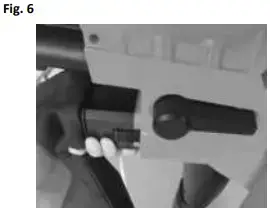
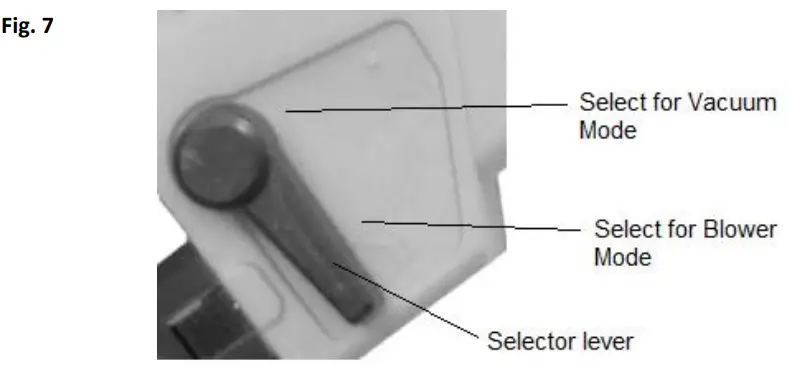
STARTING THE LEAF BLOWER VAC
Before starting the Leaf Blower Vac, ensure that the two intermediate suction/blower tubes together with the machine body are fitted correctly.
Using the Leaf Blower Vac
Do not attempt to pick up wet debris, allow fallen leaves etc, to dry out before using the Leaf Blower Vac.
The Leaf Blower Vac can be used to blow debris from patios, paths, driveways, lawns, bushes and borders. It will also pick up leaves, paper, small twigs and wood chippings. When the using the Leaf Blower Vac in Vacuum mode, the debris is sucked up through the suction tube before being ejected into the debris collection bag, as the debris passes through the suction fan it is partially shredded. The shredded organic debris is ideal to use as mulch around plants.
Warning! Any hard objects, such as stones, tin cans glass etc, will damage the suction fan.
Important
Do not use the Leaf Blower Vac to suck up water or very wet debris.
Never operate the Leaf Blower Vac without the debris collection bag fitted.
Operating the Vacuum-Blower
WARNING: IF THE CORD HAS BEEN DAMAGED, HAVE IT REPLACED BEFORE USING THE BLOWER.
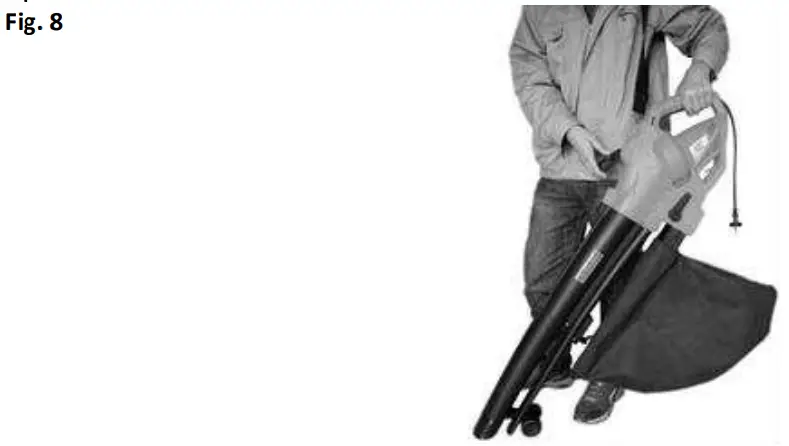
Blower mode
Inspect the area to be worked before starting. Remove any objects or debris that could be thrown, jammed or become entangled in the Leaf Blower Vac.
Select the blow function using the selector lever on the side of the machine (Fig.7) and switch on. With the Leaf Blower Vac resting on its wheels, move the Leaf Blower Vac forwards directing the nozzle at the debris to be cleared.
Alternatively hold nozzle just above the ground and swing the machine from side to side, moving forwards and directing the nozzle at the debris to be cleared. Blow the debris into a convenient heap then use the vacuum function to collect the debris.
Vacuum mode
Inspect the area to be worked before starting. Remove any objects or debris that could be thrown, jammed or become entangled in the Leaf Blower Vac. Select the vacuum function using the selector lever on the side of the machine (Fig. 7) and switch on. With the Leaf Blower Vac resting on its wheels move the Leaf Blower Vac forwards directing the nozzle at the debris to be collected. Alternatively with the Leaf Blower Vac held just above the ground swing the machine from side to side, moving forwards and directing the nozzle at the debris to be collected. Do not force the nozzle into the debris as this will block the suction tube and reduce the efficiency of the machine.
Organic materials such as leaves contain a large amount of water that can cause them to stick to the inside of the suction tube. To reduce sticking the material should be left for a few days to dry out.
Operation illustration

WARNING: WHEN DISCHARGING THE LEAVES WHICH HAVE BEEN SHREDDED, DISCONNECT THE PLUG TO THE MAIN POWER SUPPLY AND PUT THE SWITCH TO OFF POSITION.
MAINTENANCE, CLEANING AND STORAGE
 WARNING! BEFORE CARRYING OUT ANY CHECKS OR MAINTENANCE OPERATIONS, DISCONNECT THE PLUG FROM THE ELECTRIC POWER SUPPLY
WARNING! BEFORE CARRYING OUT ANY CHECKS OR MAINTENANCE OPERATIONS, DISCONNECT THE PLUG FROM THE ELECTRIC POWER SUPPLY
- CHECK YOUR MACHINE REGULARLY BEFORE STARTING TO WORK. MAKE SURE THAT ALL NUTS, BOLTS AND SCREWS ARE TIGHT AND THAT THE GUARDS ARE FITTED CORRECTLY.
- ALL DAMAGED AND WORN PARTS SHOULD BE REPLACED IN ORDER TO MAINTAIN THE LEAF BLOWER VAC IS IN A SAFE WORKING CONDITION.
- NEVER LEAVE MATERIAL IN THE LEAF BLOWER VAC OR THE DEBRIS COLLECTION BAG. THIS COULD BE DANGEROUS WHEN STARTING THE LEAF BLOWER VAC.
- AFTER USE THE LEAF BLOWER VAC SHOULD BE THOROUGHLY CLEANED.
- ENSURE THAT THE LEAF BLOWER VAC IS SWITCHED OFF AND DISCONNECTED FROM THE MAINS SUPPLY. REMOVE AND EMPTY THE DEBRIS COLLECTION BAG. ENSURE THAT THE VACUUM / BLOW SELECTOR LEVER OPERATES SMOOTHLY AND THAT IT IS NOT OBSTRUCTED BY DEBRIS. BRUSH ANY LOOSE DEBRIS FROM AROUND THE FAN AND INSIDE THE SUCTION/BLOWER TUBE.
- ALWAYS KEEP THE VENTILATION SLOTS IN THE MOTOR HOUSING CLEAN
- NEVER CLEAN OR SPRAY A MACHINE WITH WATER. CLEAN THE MOTOR HOUSING ONLY WITH A MOIST CLOTH AND NEVER USE DETERGENTS OR SOLVENTS! THESE COULD RUIN THE PLASTIC PARTS OF THE MACHINE. FINALLY, DRY THE MOTOR HOUSING CAREFULLY.
- STORE THE APPLIANCE IN A DRY PLACE, OUT OF REACH OF CHILDREN.
- IF THE REPLACEMENT OF THE SUPPLY CORD IS NECESSARY, THIS HAS TO BE DONE BY THEMANUFACTURER OR HIS AGENT IN ORDER TO AVOID A SAFETY HAZARD.
WARNING: FOR YOUR OWN SAFETY THIS Leaf Blower Vac IS DOUBLE INSULATED, TO AVOID ELECTRICAL SHOCK, FIRE, OR INJURY, USE ONLY PARTS IDENTICAL TO THOSE IN THE PARTS LIST. REASSEMBLE EXACTLY AS THE ORIGINAL ASSEMBLY TO AVOID ELECTRICAL SHOCK.
DISPOSAL
- Coopers of Stortford use recyclable or recycled packaging where possible.
- Please dispose of all packaging, paper, cartons, packaging in accordance with your local recycling regulations.
- Plastics, polybags – the handle is made from the following recyclable plastic.
Code & Symbol 




Type of Plastic High-Density Polyethylene Polyvinyl Chloride Low Density Polyethylene Polypropylene Please Specify (includes ABS, Nylon) Commonly used for Milk bottles, cleaning product bottles, yoghurt pots, butter tubs and other food containers Pipes, construction material, flooring, windows, guttering, plaster packs Shopping bags, bread bags, squeezy bottles, stretch/pallet wrap, bubble wrap, multi- pack can holders Microwaveable food containers, yoghurt pots, butter tubs, disposable plates and cups CD’s, crisp packets, various flexible packaging, baby bottles, sunglass lenses Notes Commonly recycled and collected from household recycling bins.
Check with your local authorityNot usually collected from household recycling bins, Sometimes recycled at local waste management centres. Usually recyclable supermarket deposit points.
Check other plastic films as any non-polythene film e.g. cling film, crisp packets film lidsCommonly recycled and collected from household recycling bins (packaging tape itself not recyclable but does not interfere with cardboard) Not often or widely recycled - At the end of the product’s lifespan please check with your local council authorised household waste recycling centre for disposal.
DECLARATION OF CONFORMITY
Coopers of Stortford confirms that the Leaf Blower Vac 9242, (Model No. DT2206A) conforms to the following European Directives and standards
- Machinery Directive 2006/42/EC
- Low Voltage Directive 2014/35/EU
- EMC Directive 2014/30/EU
- Noise Directive 2000/14/EC & 2004/88/EC
- RoHS Directive 2011/65/EU
The Technical file in accordance with 2006/42/EC is available from:
Coopers of Stortford, 11 Bridge Street, Bishop’s Stortford, Hertfordshire, CM23 2JU
Head Office, 11 Bridge Street, Bishop’s Stortford CM23 2JU
Tel: 0844 482 4400*
Fax: 01279 756 595
www.coopersofstortford.co.uk

